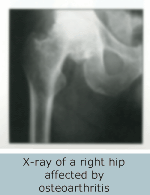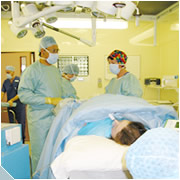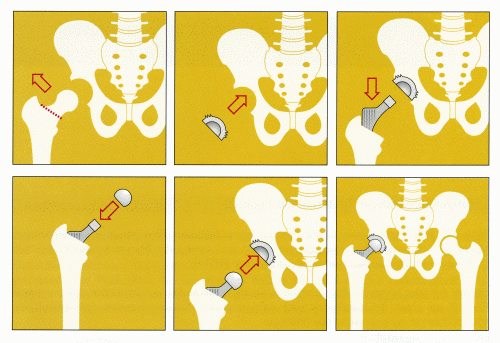


Bristol Knee Clinic

| + home | |
| + news | |
| + research | |
| + patient information | |
| + the clinic | |
| + the surgeon | |
| + sport physiotherapy | |
| + sports advice | |
| + medico legal | |
| + products | |
| + resources | |
| + contact | |
| + maps | |
| + directions | |
| + site map |
The Bristol Knee Clinic |
Total Hip Arthroplasty - Surgery
Prior to Surgery
Walking Aids:
If pain is experienced during walking this may be eased in several ways. A walking stick may be helpful when used in the opposite hand to the painful hip. If there is a difference in the length of your legs, help may be gained by a shoe raise on one side. This can be manufactured to fit un-noticed into your shoe.
Prior to surgery it is important to strengthen the muscles of the leg and to reduce the stiffness of the hip joint. Regular exercises for a half hour, perhaps three times a day, should be undertaken to achieve this. Whilst lying on your back, the straight leg should be lifted and held for 5 to 10 seconds, rest for 5 or 10 seconds and begin again. This should be repeated 10-50 times. Hip bending is achieved by lying on your back whilst bending the hip and hip, pulling the thigh up onto the stomach and chest. The abductor muscles on the outside of the hip joint are strengthened by lying on one's side and lifting the straight leg up to the side. Swimming is also a very useful exercise.

Prior to admission to hospital, blood tests, a urine test, a hip X-ray, a chest X-ray and an ECG or heart tracing will be performed. Blood will be cross matched so as to be available for transfusion following surgery. If you wish to arrange for your own blood to be pre-donated and ready for autologous transfusion, this should be done some weeks in advance and will require a trip to the blood bank on several occasions. Prior to the operation any tablets or medications you take, or allergies you may have to medications, should be brought to the attention of the Surgeon. You should stop anti-inflammatory arthritis tablets for one week prior to surgery. Take only Paracetamol for pain relief during this period. Please notify your Surgeon and Anaesthetist in advance if you are taking any anti-coagulants (blood thinners), hormone tablets or suffer from diabetes.
Medication:
In order to relieve the pain of arthritis painkillers may be prescribed. You may be instructed to take the tablets regularly or when the pain is severe. If the pain is particularly bad at night, relief may be achieved if the tablets are taken before going to bed. Anti-inflammatory tablets are commonly used in the treatment of arthritis. These tablets reduce the inflammation in the joint as well as acting as pain killers. The tablets may cause stomach upset and should therefore be taken with food. If, despite this, the pain continues, then the dose should be reduced or even stopped if necessary.
Surgical Technique

A general anaesthetic is generally used, sometime a spinal injection is preferred. To be able to replace the hip joint an incision is made down the side of the hip and the joint is opened. The length of incision may vary from 5-10 cm if minimally invasive surgical techniques are used to 15 - 20 cm in conventional surgery. The bone is shaped so that the joint replacement components sit firmly within the bone. The components will either be fixed with acrylic cement, or for young patients special components with a roughened or porous surface will be used. The bone then grows into the roughened surfaces anchoring it without the use of cement.
Once the total hip replacement has been inserted, the joint is closed over drainage tubes to take away the bleeding from the joint. They stay in the hip for one or two days. The hip will have a dressing. You will have a drip to administer fluids whilst you do not feel like eating or drinking. A blood transfusion may be given if required. Initially the hip may be painful. Powerful pain-killing tablets and injections will be prescribed. It is usual for these to be required for 1 or 2 days, so do not be afraid to ask for something if you are in pain. Further blood tests and X-rays will be taken. Injections or tablets to thin the blood and to prevent thrombosis will also be given.
Minimally Invasive Surgery; MIS
Minimally invasive surgery involves the use of smaller wound incisions and special instrumentation to enable surgery to be undertaken. These techniques can result in advantages in respect to improve the speed of recovery, speed of mobilization, shorten hospital stay reduce the period off work and reduce the time until functional and sporting activities can be resumed. The recovery from the operation requires about 3-7 days in hospital. In this time physiotherapy is commenced.

A schematic diagram of the operative steps to an uncemented total hip replacement.
i ) The head of the femur is resected,
ii) The acetabulum is reamed and the acetabular component seated,
iii) The femoral prosthesis is inserted into the shaft of the femur,
iv) The spherical head of the femur is placed on the trunion of the femoral component,
v) the hip is reduced into the socket of the acetabulum,
vi) The completed hip replacement.

An X-Ray of an uncemented total hip replacement.
Wound Dressing and Sutures
The wound dressing which is applied in theatre may be removed after 4 days if the wound is satisfactory. The sutures should be removed by the General Practitioner or Practice Nurse after 12 days. Sometimes arrangements are made for patients to return directly to the hospital for this.
< BACK to Non-operative Treatment | NEXT: Recovery and Rehabilitation >
Related Links..
+ How to make an appointment
+ Total Hip Arthroplasty - see all links
+ Patient Information Home
+ See the clinic
+ More about Mr Johnson
+ top
© The Bristol Orthopaedics and Sports Injuries Clinic 2003. The Bristol Knee Clinic is a trading name of the Bristol Orthopaedic Clinic Ltd. privacy / copyright | contact | Powered By Create Medical



